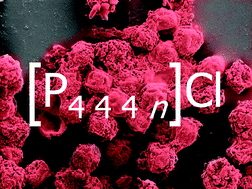Because of their distinctive properties, in particular their negligible vapor pressure, ionic liquids have attracted increasing attention in many fields, including organic chemistry, electrochemistry, catalysis, physical chemistry. However, the toxicity including ecotoxicity of these so-called a “green solvent” has recently received broad attention.
 In this NJC paper C. S. Pereira and co-workers (collaborative research work between the Universities in the UK and Portugal) have investigated the toxicity of quaternary phosphonium ionic liquids towards fungal conidia Aspergillus nidulans.
In this NJC paper C. S. Pereira and co-workers (collaborative research work between the Universities in the UK and Portugal) have investigated the toxicity of quaternary phosphonium ionic liquids towards fungal conidia Aspergillus nidulans.
This interesting work reveals the mechanism of toxicity of the tetraalkylphosphonium chlorides, demonstrating that systematic elongation of the alkyl substituents result in generally higher toxicity. In this study, fluorescence microscopy is proposed as a direct method for assessing the impact of ionic liquids on the plasma membrane integrity.
Unravelling the mechanism of toxicity of alkyltributylphosphonium chlorides in Aspergillus nidulans conidia; Marija Petkovic, Diego O. Hartmann, Gabriela Adamová, Kenneth R. Seddon, Luís Paulo N. Rebelo and Cristina Silva Pereira; New J. Chem., 2011, Advance Article; DOI: 10.1039/C1NJ20470J, Paper
Interested to know more? Why not read by accessing the full article now! This “Hot article” will be Free to access for a period of 4 weeks.










